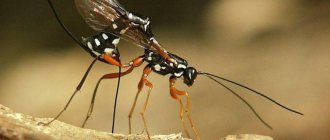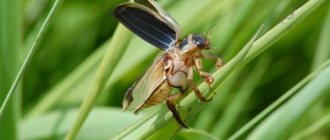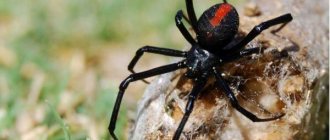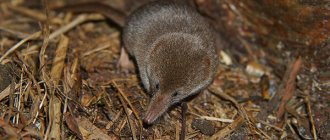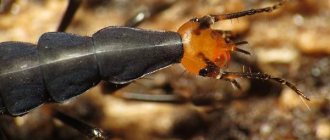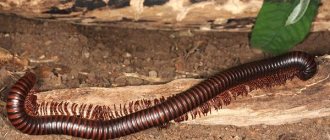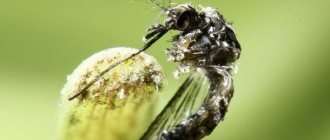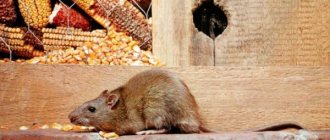- Encyclopedia
- Biology
- Mosquito
A mosquito is a blood-sucking insect belonging to the Diptera family. It lives on all continents (except Antarctica) and is represented by 3000 species. Scientists believe that his distant ancestors existed on Earth 145 million years ago.
In the tropics and other regions where there is a lot of heat and high humidity, it is active all year round. And in areas with moderate climatic conditions during the cold season, it overwinters, falling into torpor.
On the path of development, the mosquito goes through 4 phases. The first phase is the egg laid in the water. After a couple of days, a small larva emerges from it, which molts and pupates after a few weeks. After the pupa develops wings and legs, it becomes an imago, that is, an adult.
The length of the thin body of this insect is small - 4-14 millimeters. The chest is wider than the abdomen, consisting of 10 segments. There are claws at the end of the long legs. The wings are narrow and transparent. They are covered with scales, in places where they accumulate, spots form. Their span can reach 5-30 millimeters.
The lips are elongated. The lower lip is tube-shaped. It contains a piercing-sucking mouthparts. The antennas are long. They contain olfactory organs and receptors that act as thermal sensors, with the help of which the mosquito detects its prey. Interestingly, male mosquitoes, unlike females, cannot bite because their jaws are underdeveloped.
In nature, the lifespan of mosquitoes depends on several factors: nutritional status, environment, habitat temperature and gender. For example, the average lifespan of a male is 17-20 days, and that of a female is 42-56 days.
The sources of nutrition for males are plant juices and nectars. To produce energy and reproduce numerous offspring, females need blood, from which they obtain protein, which plays an important role in the production of eggs.
Mosquitoes are carriers of various diseases that affect both animals and humans. When they bite, they inject a substance under the victim's skin that interferes with the blood clotting process. It is the cause of itching, swelling and redness (and in some cases, a severe allergic reaction).
Today, to protect against and combat mosquitoes, people use environmental, biological, physical, chemical, technical and folk remedies, as well as devices that create ultraviolet radiation (mosquito lamps).
Features and habitat
There are no people who have not come across this annoying creature closely. The ultra-fine squeak of mosquitoes cannot be confused with anything else. In the summer they are found everywhere, especially in places with high humidity.
These insect mosquitoes are comfortable in countries with hot and humid climates. Their activity there manifests itself throughout the year. Mosquitoes are almost everywhere.
The only exception is the territory of Antarctica. In countries where a temperate climate prevails and there are cold periods, mosquitoes simply hibernate during this time. And as soon as the warmth arrives, the insects awaken.
You can also spot these bloodsuckers in the Arctic, where only a couple of weeks are allotted for warmth. During this short time, mosquitoes manage to multiply in huge numbers and bite the few animals that live there.
Tiger mosquito
If you look at a photo of a mosquito insect , you cannot immediately understand how harmful this tiny creature can be to humans. In fact, this widespread blood-sucking creature is of enormous epidemiological importance.
There are many varieties of mosquitoes, but their structure and external characteristics are almost the same. The average squeak mosquito is 3-5 mm in size. Other species reach up to 14 mm. The color of the insect is dominated by gray and brown tones.
There are species with a variegated range of colors with a predominance of yellow, green, and red flowers. Almost all of their representatives have wings, but there are also mosquitoes that do not have them at all. The wings and legs of insects are covered with lush brushes.
A distinctive and important organ of insects is the antennae, which contain important receptors and olfactory organs. They help mosquitoes find their prey.
Only females need blood. Especially during the birth of offspring, females simply need this. Males also have enough plant juices. In fact, in this couple one is a bloodsucker, the other is a vegetarian.
An ordinary, familiar small mosquito, the squeak, can seriously harm human health - in many cases it can spread viruses such as meningitis, infectious eczema, etc. Therefore, mosquito bites are not only painful, but also dangerous.
The oral organ of females and males has some differences. If you look at a mosquito through a magnifying glass, you will notice the elongation of its lips, reminiscent of a kind of case.
Behind this “case” are jaws covered with teeth. The insect's teeth are needle-thin. This is what the female’s oral cavity looks like. In the male it is slightly underdeveloped, which does not give him the opportunity to make a hole under the skin and feed on human blood. Therefore, only the female is bloodsucking.
The insect can fly very quickly. Its speed is 3.3 km/hour. With the help of air currents, mosquitoes can cover a distance of 100 km. The insect weighs so little that, once in the web, it does not even attract the attention of the spider; there is not the slightest fluctuation from its weight.
If we talk about the life cycle of an insect, it consists of some phases of transformation. The eggs laid by the female eventually turn into larvae, which after 4 moults pass into the pupal stage. The pupae, in turn, turn into mature mosquitoes, blood-sucking insects.
that a mosquito is a harmful insect since childhood. Therefore, people are trying in every possible way to fight mosquitoes. All insects similar to mosquitoes everywhere and always aroused hostility among people.
Lifestyle of mosquitoes
In many species of mosquitoes, the diet of males and females differs significantly. Males, like many other insects, feed on flower nectar and plant juices. Females can also use these substances for food, but their oral apparatus is structured somewhat differently. As a result of this, they are able to pierce the skin of animals, feeding on blood from the capillaries adjacent to its surface.
In some species, female mosquitoes do not use the parasitic method of feeding all the time, but only during the breeding season. The nutrients they obtain from the blood of their host animals may be necessary for them to produce eggs. Therefore, the activity of mosquitoes as blood-sucking insects significantly depends on the time of year, weather and the characteristics of the life cycle of a particular species of these insects.
The period of greatest mosquito activity occurs from May to October, if we talk about the temperate climate zone. Peak mosquito activity may occur in different months in different regions, depending on climatic conditions.
Mosquito habitats
In the wild, mosquitoes are most often found near swamps or bodies of standing water, which are their breeding grounds. Mosquitoes can lay eggs in moist soil, directly in bodies of water, or in places that are periodically flooded with water. Therefore, it is near bodies of water or in areas with high humidity that mosquitoes can cause the most trouble for travelers walking through the forest.
In cities, mosquitoes also use places with high humidity to breed. These are primarily basements and sewers. In homes where basements are flooded or partially flooded, mosquitoes can be a nuisance not only to those living on the lower floors, but to the entire home. If there are warm and damp places in the building, there is a high probability that mosquitoes will soon scatter from them throughout the house.
Only residents of regions with very cold climates are insured against such problems. As a rule, there are no favorable conditions for mosquitoes in basements. Raising buildings above the ground on stilts also reduces the likelihood of creating an environment conducive to the spread of harmful insects.
In the village, blood-sucking mosquitoes often accumulate in the premises where animals are kept. They prefer places where little light penetrates. In the city, they often appear on the walls and windows of rooms, especially at night.
Character and lifestyle
Mosquitoes are not harmless insects. Their females are real parasites who need to feed on someone else's blood for their continued existence and production of offspring.
Often their bites become fatal for people, because mosquitoes carry a wide variety of diseases dangerous to people. Insects are distinguished by amazing endurance, but they do not live in too cold climatic conditions.
In places with a temperate climate, mosquitoes are active from late spring to October. With the early arrival of spring, their appearance can be observed in April.
In the summer, they can be everywhere - in a living room, on the street, in the forest, near a pond. In winter, mosquitoes find refuge in barns with livestock, in basements and other buildings.
Developing mosquito-like speed, insects can cover a distance of 1 km; females especially practice such flights when they are looking for something to profit from.
Mosquitoes are the root cause of many ruined outings and just restful nights in a living room. Therefore, people have long made sure that in such situations they always have the necessary mosquito repellents.
A variety of methods are used to combat these insects. People have never learned to completely destroy squeakers, but they still manage to protect themselves from them.
mosquito repellers have long proven their worth which you can turn on in your living room and not be afraid of being woken up or bitten by an insect at night. These devices have very different structures, but the benefits from them are incredible.
During camping and expedition conditions, people are saved by various ointments from mosquito and insect bites . There are ointments that help relieve symptoms of itching and allergic reactions caused by mosquito bites. They help avoid severe negative consequences in the form of swelling and inflammatory processes.
Mosquito description
There are 4 main stages in the life cycle of a blood-sucking insect:
- Mosquito eggs.
- Small larva. It is similar in body structure to a worm. Avid fishermen often call the larvae bloodworms, and also use them to feed aquarium and river fish.
- Doll.
- Imago or adult individual. How much an adult mosquito weighs depends on the species.
The length of a mosquito's life cycle depends on the species. Some varieties live 2–3 months, others up to a year.
The structure of a mosquito is standard. It has a thin body, the length of which is 0.4-1.4 cm. Almost all varieties have long legs and working wings. People often confuse the Culexes they encounter indoors or in the forest with the Caramors (long-legged ones). Although centipedes with long limbs have an unpleasant appearance, they feed only on plant foods.
Blood-sucking insects have two pairs of wings with dark spots. The second pair of mosquito wings is practically not used. During flight, the insect makes up to 900-1,000 strokes. When approaching a person, you get the feeling that mosquitoes are squeaking. This effect occurs due to the fact that the insect makes a huge number of flapping of its wings. That's why blood-sucking mosquitoes squeak and people hear this sound.
When examining an insect under a microscope or magnifying glass, you can see the abdomen, which is divided into segments or strips. The number of stripes depends on the species. The chest is wide because it covers the internal organs. To study the insides, scientists made a cut. The legs of a mosquito are supplemented with claws, with the help of which it attaches to various bases and human skin. Based on how many legs the mosquito in question has, scientists determine its species. Insects also differ in shade. In nature, there are species with a green, gray or yellow color. The black mosquito can be found in basements or garbage dumps.
The head of a mosquito has a unique structure. The tactile organs, which include the antennae, are concentrated on it. The structure of the antennae is relatively simple. Each antenna includes about 15 segments, with the help of which space is studied. This difference between a mosquito and a squeak must be taken into account. Black and white eyes are concentrated on the head, with the help of which pests can see objects and find a victim. The mouthparts of a blood-sucking mosquito have a special structure. The weight of a blood-sucking insect is about 2.5-3 years.
Mosquito feeding
As already mentioned, mosquitoes are bloodsuckers. Without blood, the female may not be able to produce offspring. The male, having a different structure of the oral cavity, feeds exclusively on plant nectar, and this food suits him quite well.
Sometimes the female allows herself to diversify the menu with plant juices. A mixture of blood and plant food helps the female produce more strong offspring. But for building materials, when carrying eggs, the female still needs protein, which can be easily found in a bitten warm-blooded creature.
In general, mosquitoes prefer human blood or the blood of mammals. But there are also species whose favorite delicacy is the blood of reptiles, amphibians and fish.
Mosquitoes find their victims thanks to their well-developed sense of smell. They are attracted by the smell of lactic acid in the prey, which females sense from hundreds of kilometers away.
How long does a mosquito live?
The annoying squeak of little pests spoils the pleasure of the long-awaited summer. The situation becomes especially unbearable in rural areas or simply near forested areas. It becomes interesting: how long does the parasite live? There is no exact answer because the lifespan of a pest depends on a number of factors.
- Gender of the insect. First of all, it’s worth understanding a simple fact: males live exactly half as long as females.
- Temperature. It’s worth talking about this in more detail, because this information can help in confronting the squeaky enemy. So, the higher the air temperature, the shorter the insect will live. At a temperature of about 20°, the female will live about 42 days, and when it drops to 10°, the lifespan will increase to 115 days. In the case of a male, divide the number by two.
- Nutrition. The parasite is afraid of both hunger and oversaturation. It is a myth that a mosquito dies immediately after biting a person. One mosquito can bite a person up to 8 times within a couple of hours. By the way, only females feed on blood, males exclusively on nectar.
Reproduction and lifespan
During the mating season, females produce an incomparable squeak, which they produce due to the movements of their wings. This sound attracts males. Moreover, the sound of mosquitoes of different ages is different.
The mosquito catches these differences and chooses an adult female capable of childbearing. In the swarm formed by mosquitoes, the process of mating of females with males occurs. After this, eggs are laid.
Sometimes their number can reach up to 290 pieces. This process can be repeated every 3 days. After going through all the phases of its development, an adult mosquito is eventually born. The lifespan of males and females is slightly different. The first ones usually live no more than a month. Females are given a longer period - about 2 months.
Life cycle
The life of each female mosquito is strictly scheduled in stages: searching for a victim and attacking it, sucking blood, digesting blood and maturing eggs, searching for a reservoir and laying eggs. Then everything can happen again.
Larva
Mosquito larvae develop in water.
Nutrition. The larvae feed on the dead remains of plants and small aquatic animals, bacteria, protozoa, unicellular algae, as well as spores and pollen of plants that have fallen into the water.
Movement. The larvae swim, sharply bending their body from side to side with jerks. They often float up and, attaching the end of their abdomen to the surface film of water, take in air for breathing.
Doll Material from the site https://doklad-referat.ru
Having completed development, the larvae pupate. The mosquito pupa looks exactly like a large living comma, but with “horns” at the head end. “Horns” are a pair of breathing tubes that the pupa exposes to the surface of the water for breathing. The pupae behave in the same way as the larvae: scared, they sink to the bottom, but then quickly rise up. Thus, mosquito pupae, unlike the pupae of the vast majority of other insects, are mobile.
When the mosquito's development inside the pupa ends, it floats to the surface of the water, the covers on its back burst, and an adult insect emerges.

